Holiday Marketing: How to Plan Your Campaigns in Advance
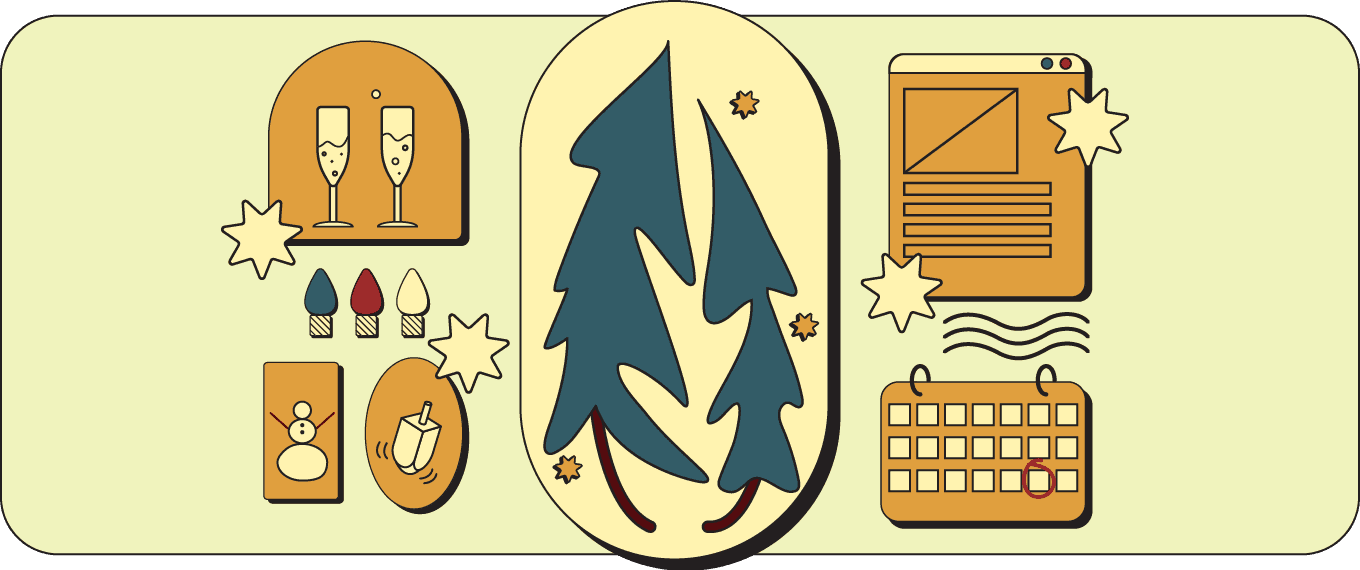 The holiday season can do wonders for your business and revenue regardless of the industry you're in, the products you sell, or the demographics you target.
People loosen up the purse strings around holiday periods. They want to take part in the merriment and traditions. It's a chance for them to splurge without feeling guilty about it because the special occasion calls for that.
This guide is going to furnish you with everything you need to create effective holiday campaigns, reach your prospects and customers, and ensure that a chunk of the money they spend during this period flows into your company's accounts.
The holiday season can do wonders for your business and revenue regardless of the industry you're in, the products you sell, or the demographics you target.
People loosen up the purse strings around holiday periods. They want to take part in the merriment and traditions. It's a chance for them to splurge without feeling guilty about it because the special occasion calls for that.
This guide is going to furnish you with everything you need to create effective holiday campaigns, reach your prospects and customers, and ensure that a chunk of the money they spend during this period flows into your company's accounts.
Holiday Marketing: How to Plan Your Campaigns in Advance via @CoSchedule
Click To TweetDownload Your Holiday Marketing Calendar
Before you move on, make sure you claim the free holiday marketing calendar which will allow you to plan all of your holiday marketing campaigns ahead of time.How Far in Advance Can You Plan Your Campaigns?
This depends on your industry and the products you're offering. Common mistakes that businesses make involve planning their holiday campaigns too early or too late or not dividing their prep work by stages. So what's the optimal time to plan for the holidays? Here are a few ideas you can run with.Starting Immediately After the End of the Holiday Season
An ideal time to prepare your next holiday campaign is when the current holiday season ends. Instead of heaving a tremendous sigh of relief and moving on to regular business operations, you need to analyze the previous campaign's performance. Try to review and understand:- The number of new users/customers your business gained.
- Your conversion rate and other relevant metrics for the holiday season.
- The percentage of carts that were abandoned and why customers failed to complete their purchases.
- How your industry fared in terms of sales and customer spending.
- Consumer behavior, shopping, and economic trends and predictions for the upcoming year.
Planning Six Months in Advance
Getting your inventory, suppliers, and stellar content ready to go six months before the holiday season starts gives you plenty of time to prepare and work out any kinks that may arise. You can use the data gathered from the past season to predict the number of items you need to stock to avoid wastage. The extra time will allow you to fine-tune your marketing copy and messaging instead of frantically adapting poorly thought-out ideas. Most consumers plan to complete their holiday shopping over a 4-8 week period. By being customer-ready ahead of time, you'll be able to service early birds who prefer to do their shopping on the dot. These shoppers are also likely to spend more than patrons who shop after the holiday season kicks off.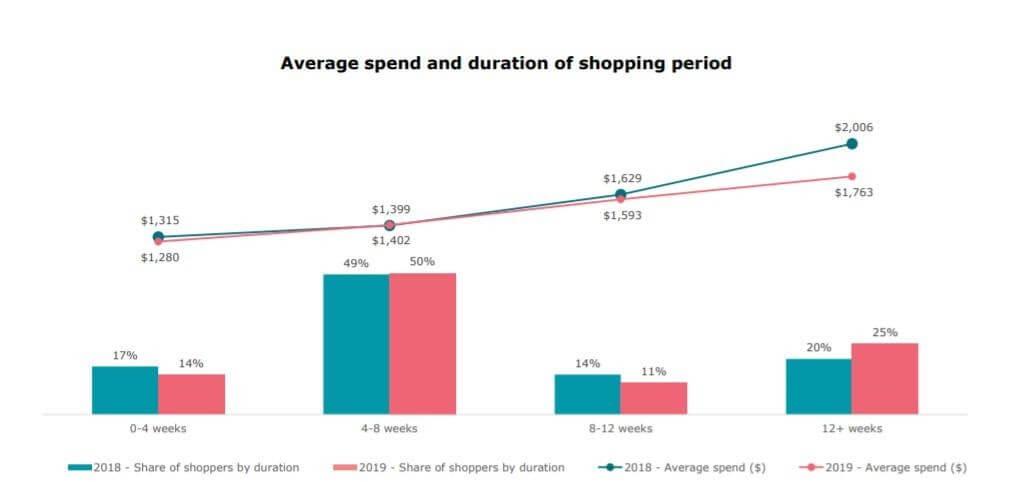 Source:Deloitte
Source:Deloitte
Planning the Previous Quarter
By this time, the holiday you're planning for is just around the corner so you should already have your goals, partnerships, and other resources figured out. The coming months need to be spent developing your campaigns for the upcoming holidays. A high-level strategy like this only serves as an overview of your game plan. Does it present your brand in the best light? Does it resonate with your target audience? Review your plan, then make any major changes before you move onto production. When the strategy is ready, you should start working on the following details for the campaign:- A creative concept
- Metrics and goals
- Marketing collateral
- Planned dates
Employing a Continuous Planning Strategy
Be ready to react quickly when the campaign goes live and make immediate adjustments where necessary.- Monitor your campaigns on launch day. Confirm that your ads and promos are collecting views and clicks as intended.
- Review A/B tests on a daily basis. Evaluate their performances and axe non-productive assets.
- Respond to customer questions and reviews immediately. Providing great customer service is especially crucial during the holiday season.
How Can You Create Your Holiday Marketing Calendar?
Effective holiday campaigns don't happen by accident, they require you to build a consistent brand experience and a narrative that's hard to resist. Following the below processes will help you develop and refine your business’s holiday marketing strategy.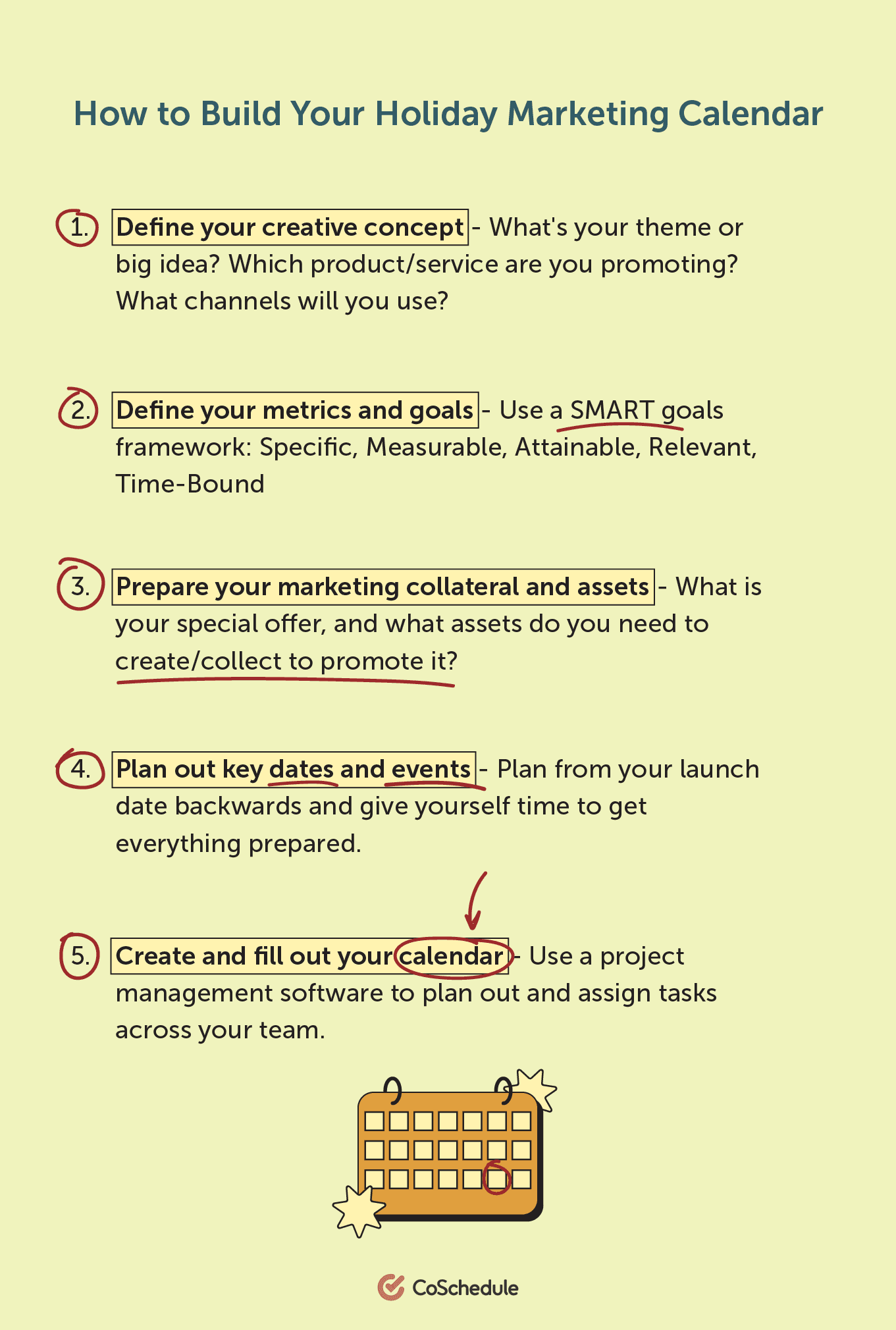
1. Define Your Creative Concept
Start by coming up with a vision for your holiday campaigns. Ask yourself:- What will be the theme or idea behind your campaign? What emotions or responses do you want it to evoke in your audience? Tag each visual asset with the emotion it’s intended to elicit. You can add tags like “urgency”, “heartfelt”, “intrigued”, “AHA-moment”, etc.
- Which product or service are going to focus on promoting? You might not be able to cram every one of your offerings into your marketing material, so prioritize.
- What channels will the campaign be shared on? Will you be collaborating with other brands or influencers to bring it to life?
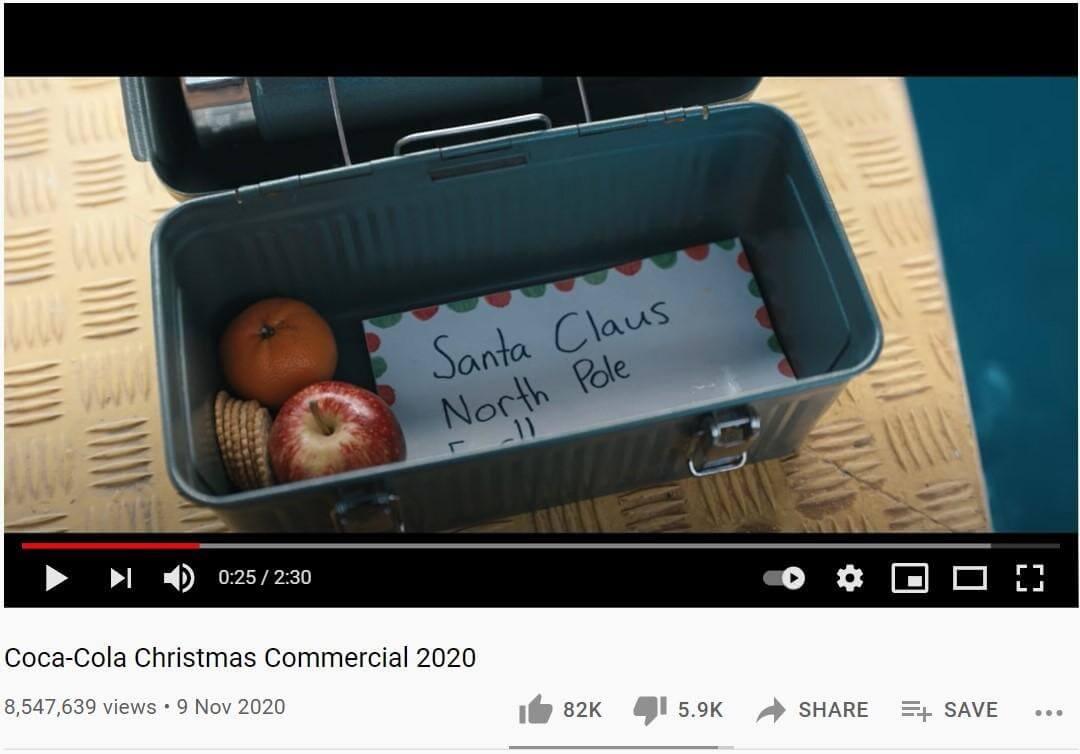 Although all hope seems lost, Santa saves the day by swooping in with a Coca-Cola truck and giving him a ride home. Turns out, his daughter's wish was for him to be home for Christmas.
The concept behind the campaign is that gifts are okay, but presence is the best present you can give to the people in your life.
Powerful, right?
Your campaigns should do more than say "Hey, it's the holidays and we're giving 20% off so buy our products!" Be creative. Tell a story. Connect with your audience on a personal level.
If you find yourself losing steam or feeling lost, return to your goal for a reminder of what you're trying to achieve.
Although all hope seems lost, Santa saves the day by swooping in with a Coca-Cola truck and giving him a ride home. Turns out, his daughter's wish was for him to be home for Christmas.
The concept behind the campaign is that gifts are okay, but presence is the best present you can give to the people in your life.
Powerful, right?
Your campaigns should do more than say "Hey, it's the holidays and we're giving 20% off so buy our products!" Be creative. Tell a story. Connect with your audience on a personal level.
If you find yourself losing steam or feeling lost, return to your goal for a reminder of what you're trying to achieve.
2. Define Your Metrics and Goals
What is the ideal result you want to generate from this campaign? Before you even create an offer, you need to know what you're hoping to accomplish. Your goals should be SMART:- Specific — Add a concrete number or percentage to your goals so you know exactly what you're aiming for. Do you want to generate leads? How many? Where will they come from?
- Measurable — Figure out the appropriate metrics you'll use in determining the success or failure of the campaign based on set goals.
- Attainable — Don't shoot for the stars unless you have a decent shot at grabbing them. Set goals you can reasonably achieve with the resources you have.
- Relevant — Your goals should benefit and align with your business.
- Time-bound — Provide a time frame for achieving your goals to help you stay on track.
- Bring customer response time on social media and email down to 30 minutes by December 20, 2021.
- Generate 40% more sales for our annual holiday sales by January 10, 2022.
3. Prepare Your Marketing Collateral
This is the point where you develop the materials needed to successfully execute your holiday campaign. The first collateral your campaign will require is an offer—the special value you'll be providing to grab your audience's attention. Brainstorm for a special offer until you find the right one for your business. Next, create a checklist of your campaign assets. Will you need to produce content like articles, infographics, templates, ad banners, emails, ad copy, and landing pages for the campaign? Here are some examples of the materials you might need to generate: Social media campaign:- Social posts (2+ per week per channel)
- Images (for organic and paid channels)
- Relevant hashtags
- Video or GIF creation
- UTM tracking
- Social media covers
- Email series (at least 3-10 emails per holiday season)
- Images
- List segmentation (e.g.: new customers vs. returning customers)
- Landing pages
- UTM tracking
- Blog posts
- Videos
- Push notifications
- Homepage banners
- Infographics

4. Plan Out the Key Dates and Events in Your Campaign
Once you've outlined your creative concept, goals, metrics, and put together your marketing collateral, it's time to determine the timelines and deadlines for each piece of the campaign. Always start from the launch date and work your way back. Allow at least 1-3 days of asset turnaround for each department. For example:- Campaign launch date: December 1
- Schedule final assets for launch: November 25-26
- Review final assets: November 22-25
- Upload blog posts, or code newsletters: November 15-19
- Create design assets: Nov 8-12
- Create copy for social media, blog posts, newsletters, etc.: Nov 1-5
- Share the marketing brief with relevant departments (designers, developers, project managers, etc.): By October 25
5. Create Your Calendar!
This is the point where you get to put all your planning and preparation into motion. Use a project management software like CoSchedule to set out the key events and dates for your holiday campaign and assign tasks to relevant teams and members. Know who will design the graphics or create campaign visuals like images and videos. Let the marketing team get to work on content, landing pages, SEO, and ad copy. Communication and collaboration is the name of the game. The timely delivery and success of your campaigns will depend on everyone doing what they're supposed to, when it's supposed to be done. Leave extra wiggle room for bigger tasks like videos or landing pages. Pro tip: Consider using a content distribution service to make sure your holiday campaigns and content reach the people you created them for, in all the nooks and crannies of the internet where they're likely to find it.fStrategies to Supplement Your Holiday Marketing Campaign
Now that you know the why, what, and how of your holiday campaigns, you need to implement strategies to maximize the impact of your marketing efforts. The following tactics will help you cut through the noise and engage your audience from one holiday season to the next.
1. Leverage Social Commerce Platforms
It doesn't matter how much time and resources you invest in your holiday campaigns. If the right people don't get to see it, it'll all have been a waste. Therefore you need to take your message to places where your audience are. Ecommerce, B2C, and DTC companies can benefit a great deal from social commerce platforms like Instagram and Pinterest. Use the Instagram Shopping feature to highlight your products and increase sales. It allows customers to shop and check out the items they like directly on the platform. Since they don't have to leave the app to complete the transaction, customers won't have time to change their minds or forget to purchase.
Pro-tips:
It allows customers to shop and check out the items they like directly on the platform. Since they don't have to leave the app to complete the transaction, customers won't have time to change their minds or forget to purchase.
Pro-tips:
- Pair creative captions and custom content with stunning holiday-related visuals..
- Add the “view store” button. You can only add this button if you have posted at least 9 shopping posts.
 Source
Combine customer service, great design, seamless user experiences, beautiful imagery, and useful product descriptions and you've got a winning Shopify store.
Source
Combine customer service, great design, seamless user experiences, beautiful imagery, and useful product descriptions and you've got a winning Shopify store.
2. Promote User-Generated Content (UGC)
Holidays are about appreciating people around you. As a business, these people are your customers and followers, and one way of showing that you see and care about them is by promoting user-generated content. UGC not only shows appreciation for the people who buy your products, it also serves as social proof, promotes your business in a low-key way, and helps to boost your content marketing efforts. For example, makeup store Juvia’s Place uses a lot of user-generated content during the holidays. They repost their fans’ tutorials and photos which frequently gets them double the amount of likes.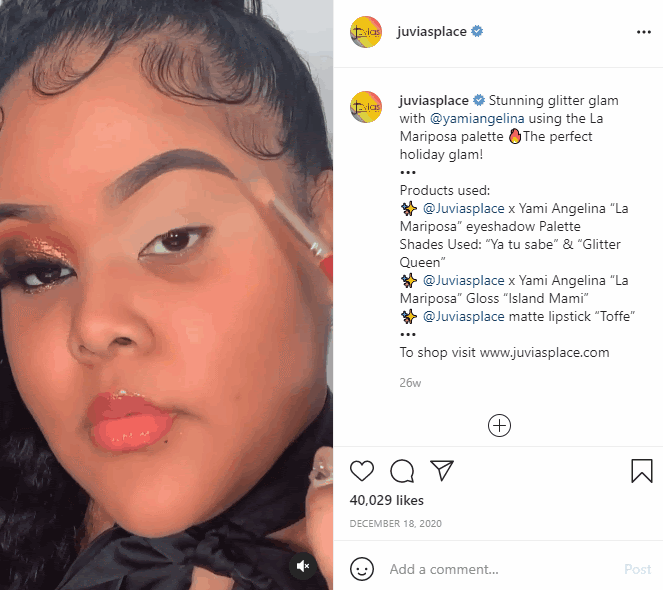 Source
You'll have an easy time implementing this strategy if you already have engaged followers who enjoy adding branded hashtags or tagging you in their posts.
And if you don't, it's never too late to encourage your customers to share UGC on their socials and elsewhere. Simply add a one-liner to your bio, website, newsletter footer and other places with a call-to-action, such as “use #companyname to get a reshare” or “add #companyname to get featured.”
Source
You'll have an easy time implementing this strategy if you already have engaged followers who enjoy adding branded hashtags or tagging you in their posts.
And if you don't, it's never too late to encourage your customers to share UGC on their socials and elsewhere. Simply add a one-liner to your bio, website, newsletter footer and other places with a call-to-action, such as “use #companyname to get a reshare” or “add #companyname to get featured.”
3. Partner With Influencers
According to recent reports:- 61% of consumers, aged 18 to 34, have been swayed in their decision-making by digital influencers at some point.
- 94% of professionals find influencer marketing to be effective at driving sales and its effectiveness increased by 18% in 2020.
- The average earned media value per $1 spent on influencer marketing has increased to $5.78.
 Source: Influencer Marketing Hub
These statistics show that collaborating with influencers can enhance the success of your holiday campaigns by putting your business in front of more people and capitalizing on the trust and loyalty of the influencer's audience.
Source: Influencer Marketing Hub
These statistics show that collaborating with influencers can enhance the success of your holiday campaigns by putting your business in front of more people and capitalizing on the trust and loyalty of the influencer's audience.
 Talk to your customers to find out which content creators they love. Use a tool like BuzzSumo to research keywords and hashtags for your industry to see which influencers are making waves in your niche.
Create a list of influencers that share your ideals, suit your brand and budget, with the right audience demographics, then reach out to them to see if they'll be interested in partnering with you for your campaign.
Plan for a lot of live content to capture the attention of your customers during the busy holiday season. You can also brainstorm with the influencers themselves as they usually know their own audience very well.
Talk to your customers to find out which content creators they love. Use a tool like BuzzSumo to research keywords and hashtags for your industry to see which influencers are making waves in your niche.
Create a list of influencers that share your ideals, suit your brand and budget, with the right audience demographics, then reach out to them to see if they'll be interested in partnering with you for your campaign.
Plan for a lot of live content to capture the attention of your customers during the busy holiday season. You can also brainstorm with the influencers themselves as they usually know their own audience very well.
4. Use Social Media Ads
Throw some money behind your campaign assets and run paid promotions on your chosen social media channels. The goal is to raise your brand profile, create hype around products and how it ties in with the specific holiday, and generate as many sales as possible. Social media ads provide a fast and easy way to do all this and more. Use one or more of the following tactics when creating holiday-specific social media ads:- Consider running a broader audience campaign at first to gather website visitors. Then set up remarketing campaigns to reach these visitors again later.
- Run multiple A/B tests for different ad creatives.
- As the holidays approach, switch to ads that convey more urgency. Urgent ads could mean more vibrant colors (red, purple, etc.), more power words (“now”, “last-minute sale”, “clearance”, etc) or even shorter/punchier ad copies.


